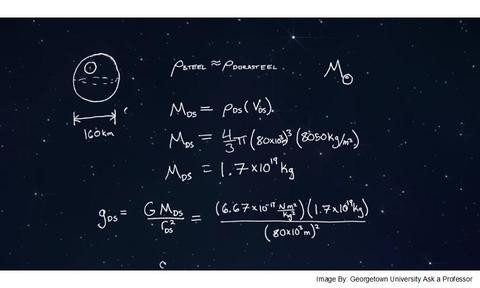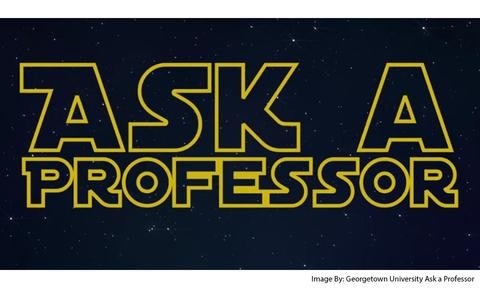
When Georgetown University Assistant Teaching Professor Patrick Johnson rallied his fellow professors to produce a Star Wars-themed educational video series, he had no idea just how popular the idea would be. Johnson—a longtime Star Wars fan with a PhD in Physics—was just interested in seeing what economics professors and political science professors had to say on the subjects of economics and political science in Star Wars. Plus, Star Wars: The Force Awakens had just debuted in theaters and Johnson was looking for a way to pay homage to a fandom he loved.
Robert Bies, a professor at the university's McDonough School of Business took on the subject Darth Vader: A Hero or Villain, concluding, “I think you can make the case that much like Luke Skywalker was on a hero's journey, I think Anakin Skywalker was on a hero's journey too.” Hans Noel, an associate professor in the university's Department of Government, and Jonathan Ladd, associate professor in the university's McCourt School of Public Policy, discussed Decoding the politics of Star Wars, ultimately agreeing that the existence of a political system that had survived “1,000 generations” was unrealistic.
For his part, Johnson looked at the physics of Star Wars, assessing the feasibility of some of his favorite concepts and moments from the movies including the two suns of Tatooine, lightsabers and the gravity of the Death Star. Johnson's motivation for helping to facilitate and participate in the series was two-fold: as a lifelong Star Wars fan, Johnson wanted to celebrate a beloved fandom and as a physicist and educator he wanted to help the public feel more comfortable with science.

Not long after the Ask-A-Professor series debuted in December of 2015, Adams Media reached out to Johnson with a proposition: expand his exploration of the Star Wars universe through the lens of physics in a book dedicated entirely to the subject. The physics professor had always wanted to write a book and the subject matter was consistent with his goal of sharing his passion for physics as a science communicator. The only real limitation was time; Johnson began the book in December of 2016 and his deadline for the first draft was early March 2017. Besides the tight timeline, it was an ideal project.
“If I had chosen it myself it could not have been more perfect,” Johnson acknowledged. “Star Wars is something that I love quite a bit. I watched the film when I was young. I saw many of the films on opening night.”
Much like Star Wars, Johnson's love for science began at an early age. “The family story goes that when I was around 2 or 3 years old I told my parents I wanted to be a scientist with dirty hair,” he said with a laugh. As a child, the “dirty hair” was based on his perception of photos of an older Albert Einstein. And while he wouldn't decide to pursue physics specifically until college, mathematics and science were a major draw.
After Adams Media reached out to Johnson, the first thing he did was sit down with his partner—who he insists loves Star Wars even more than he does—to rewatch the movies, creating a list of things he wanted to address in the book. There were some subjects Johnson knew he had to include, among them the subject of the Kessel Run being measured in distance rather than time, lightsabers, the Force, droids and hyperspace travel. But as Johnson and his partner watched the movies, he was inspired to address scenes he hadn't even remembered from earlier viewings.
While viewing Star Wars: Episode III—Revenge of the Sith, Johnson watched as a window is punctured aboard the Invisible Hand and General Grievous survives roughly 10 seconds outside the spaceship. Johnson knew he wanted to write about the entire scene and did so in a chapter titled “Invisible Hand Bridge Evacuation.” The answer to the question of whether it was feasible took Johnson by surprise. “I thought for sure he would not be able to exist outside the spaceship,” he admitted. “It turns out as long as you have the counter-pressure around his pouch of vital organs, he'll probably be OK.”

Some scientists might be disappointed to discover that the science does, in fact, play out. But Johnson wrote The Physics of Star Wars: The Science Behind a Galaxy Far, Far Away from a place of fandom and love. Ultimately, exploring the science of his favorite fandom wasn't about proving or disproving, but celebrating. “I'm not a person who says, ‘Science actually says that couldn't happen, therefore I'm not going to enjoy this movie.' I'm capable of suspending my disbelief,” he explained. “There are plenty of ways and plenty of people who say, ‘Let's prove this doesn't work.' I prefer to say, ‘Let's see how we could make this work. Let's see how this could be true.'”
Johnson suspects that the earlier films, at least, were made without a great deal of concern about scientific principles. George Lucas wanted to create an interesting world filled with compelling characters and an intriguing story. Furthermore, Johnson doesn't necessarily think that it's the responsibility of filmmakers to portray science accurately. What's more important to Johnson is that Star Wars has inspired a thriving fandom that enjoys thinking about and discussing nuances like the physics, political science and ethics of the world George Lucas created. Of course, that doesn't stop him from being disappointed when a concept is too far removed from reality. “Starkiller Base” discusses one such disappointment: Starkiller Base's use of dark energy. “You could hollow out a planet and stick a star inside it and fire it across space without even using dark energy,” he pointed out. “If you could create a device that harvests dark energy, you wouldn't need the star. I was a little disappointed with that.”
Many of the subjects that Johnson addresses in his book aren't based solely on a single scene or character but rather the concepts behind the entire world. In “Climate of Planets,” he discusses the fact that Hoth is cold and wet while Tatooine is hot and dry, attributing the latter to the fact that “it is receiving solar radiation from two stars.” In “Biodiversity in the Galaxy” Johnson asks: “Is it reasonable to assume that one galaxy would have hundreds of different alien life-forms?” Utilizing the Drake equation, “our current method for estimating life in the universe” Johnson fails to reach a definitive answer. The Drake equation involves the fraction of stars that have planets, the average number of planets per star that can support life, the fraction of Earth-like planets that have life, the fraction of planets that have yielded intelligent life, the fraction of intelligent life forms that have developed communication and the lifetime of these civilizations' communications. Ultimately, Johnson uses the Drake equation to conclude that considering the distance between planets and relatively short existence of empires capable of attempting to communicate with space, any such communication is highly unlikely. But ever the optimist, he's unwilling to outright deny the possibility.
“Life formed on one planet for sure,” he said of the planet Earth. “Some people say it's a singular planet but just because it seems fairly unlikely does not mean it can't happen. Even very rare things can happen if given enough time.”
When people learn that Johnson wrote a book about the physics of Star Wars there are certain questions that fans like to ask. However, the queries generally differ based on the fan's age. Children like to ask about lightsabers and blasters. Adults almost always ask about the concept of relative aging.
Looking forward, Johnson is interested in writing more books about the physics of other fandoms but choosing the right one is challenging. Some—like the Marvel Cinematic Universe—have already been done while others—like Game of Thrones or Lord of the Rings—rely too heavily on magic for the kind of scientific study that interests him. In the meantime, he's got his hands full developing educational tools using virtual reality.
Love Star Wars? Check out the Jabba's Skiff-themed Star Wars Smuggler's Bounty Box available exclusively on Amazon.








 Items in your cart may be affected with updated location.
Items in your cart may be affected with updated location.




































